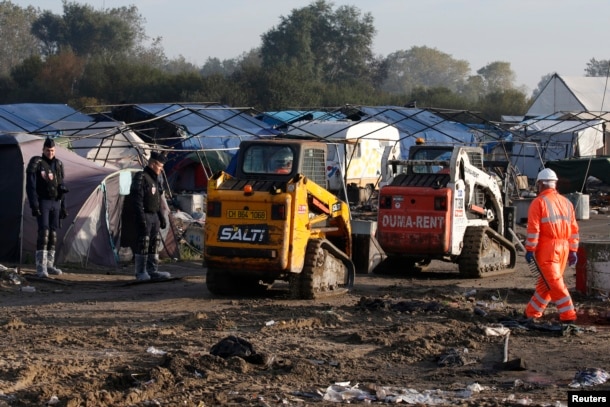
Workers Demolish Calais ‘Jungle’ Refugee Camp
Final demolition work began at the “jungle” refugee shelter in Calais, France, Thursday morning after authorities declared the camp empty a day earlier.
Workers used large construction equipment and machines to rip down the make-shift shelters, some of which had been badly burned by refugees setting fires Wednesday before they were forced to leave.
Firefighters put out blazes set by departing migrants who acted in keeping with a tradition of burning their tents, despite being told not to do so.
French authorities conducted the operation to clear what had become a symbol of Europe’s refugee crisis and resettle migrants who had lived in dire conditions in the camp.
A spokesman for regional authorities said one migrant was hospitalized with minor injuries. About 100 migrants were evacuated Tuesday night and Wednesday morning.

Thousands transferred out
French authorities say about 4,000 people have been transported to reception centers across France since dismantling of the Calais camp began Monday.
Calais Prefect Fabienne Buccio told reporters Thursday new migrants at the camp will not be resettled by local authorities and an on-site resettlement center that had been sending refugees to reception centers across the country was now closed.
“It is not Calais’s role to receive all the migrants of Europe,” he said. “We do not want to create a vacuum. We have asked (those newly arrived) migrants to disperse.
The camp, which was used to temporarily house 6,000 to 8,000 migrants, will be completely cleared by Monday morning, Buccio said.

French CRS riot police secure the are as workmen and heavy machinery continue to tear down makeshift shelters and tents in the «Jungle» during the dismantlement of the camp in Calais, France, Oct. 27, 2016.
Notorious
Calais gained notoriety in the past two years as one of Europe’s biggest slums for migrants and refugees, mainly Afghans, Sudanese and Eritreans, arriving there in hopes of reaching Britain a short distance across the sea.
There have been various refugee camps around Calais since 1999, when The French Red Cross opened and administered a reception facility named Sangatte, which quickly become overcrowded.
Since then, migrants set up makeshift shelters on unoccupied land and kept moving to new locations when camps were closed by the French authorities.

